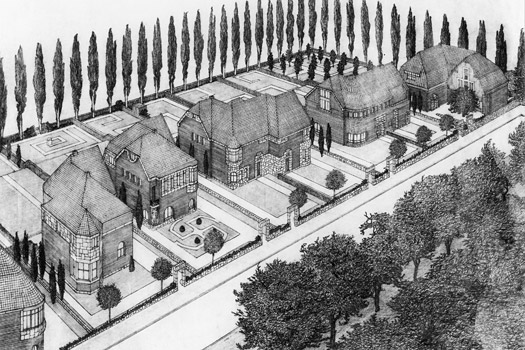
Villenkolonie Am Stirnband
Diese Zeichnung zeigt den Entwurf für die Villenkolonie Am Stirnband in Hagen.
© Bauzeichnung von Mathieu Lauweriks. Reproduktion LWL Amt für Denkmalpflege in Westfalen
Kunst zurück zur Auswahl
Hagen as a centre of an European network of modernity
The term "Hagener Impuls" (Hagen Impulse) coined by Nic Tummers in his 1964 review describes a period in the history of the Ruhr Region whose starting point and main centre was the place called Hagen, south of Dortmund, but extended its influence throughout the entire Ruhr Region, and shone well beyond - as Emil Nolde wrote in his memoirs - like “a celestial sign over western Germany". This new town, was the scene of an internationally significant civic initiative at the start of the so-called modern era: during 1900-1921, the banker Karl Ernst Osthaus ( born in 1874) a patron, agent and organiser, tried to realise his vision in his hometown to let: “beauty be the main driving force of life again".
Karl Ernst Osthaus launched numerous projects in Hagen, which developed the young industrial town into a centre of the modern movement of fine and applied art, and architecture, thus securing a permanent place for it among the cultural highlights of the Ruhr Region. The founding and opening of the Folkwang Museum in 1902 was the first of many such projects: the construction of the Villa Colony Hohenhagen featuring buildings by Peter Behrens, the Belgian artist Henry van der Velde and the Dutch Johannes Ludovicus Matheus Lauweriks, in the suburbs of Hagen; the establishment of strong connections of important artists to the town, who Osthaus called to Hagen, or those he commissioned for Hagen-based projects or ones extending beyond Hagen. In addition to the painter Christian Rohlfs, the architect Lauweriks and the sculptor Milly Steger from Berlin, Osthaus was also able to secure the Dutch painter Johan Thorn Prikker for Hagen. Steger, Prikker and Lauwerik, lived in houses designed for them in the villa colony of Hohenhagen.
The specific character of Karl Ernst Osthaus's efforts, known today as “Hagener Impuls” , limited to only a manageable settlement or architecture exhibitions. Osthaus' attempt to transform social life through art was indeed reflected in the social realities of the entire industrial town. Therefore, the influences of the “Hagener Impuls” are found throughout the town as well as in different functional contexts such as: a workers' settlement represented by Richard Riemerschmid; the first monumental work of stained glass of the modern age at the Hagen Hauptbahnhof by Johan Thorn Prikker; the painting and stained glass of the Essen Friedenskirche also by Thorn Prikker; and the Eduard-Müller crematorium by Peter Behrens.
During these first twenty years of the 20th century, Hagen was one of the most important centres internationally for the development of the Modern Age. External signs of this general reform movement, which opposed the traditional structures of Wilhelmine Germany, was the so-called “Jugendstil” (art nouveau), which was represented throughout Germany by artists and architects such as Behrens, van der Velde and Riemerschmid. Through Osthaus' connection with the German Werkbund, Hagen is also an example of the development of the “Jugendstil” into more basic forms of design, which later flourished particularly in the Dessau and Weimar Bauhaus after the first world war.
Denkmale zum Impuls
Hagen - Eduard-Müller-Krematorium
Die Idee der Feuerbestattung war im 19. Jahrhundert aus hygienischen Überlegungen wieder ... weiter
Hagen - Hohenhof
Nach dem Vorbild der Mathildenhöhe in Darmstadt sollte in Hagen die Gartenstadt Hohenhagen ... weiter
Hagen - Gartenvorstadt Hohenhagen
Die Gartenvorstadt Hohenhagen wurde am Anfang des 20. Jahrhunderts von dem Hagener Bankier und ... weiter
Hagen - Bahnhofsfenster von Jan Thorn Prikker
Das große Stirnfenster im Hagener Hauptbahnhof ist von Jan Thorn Prikker 1911 für die ... weiter
Essen - Altkatholische Friedenskirche
Mitten im Ersten Weltkrieg wurde 1916 die Kirche der altkatholischen Gemeinde in Essen unter dem ... weiter
